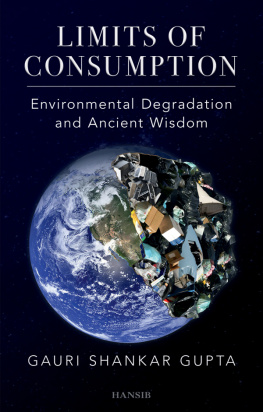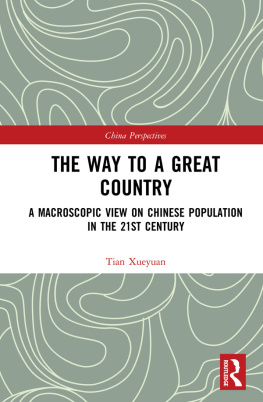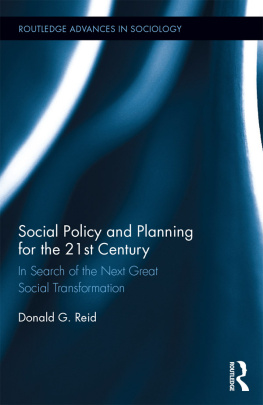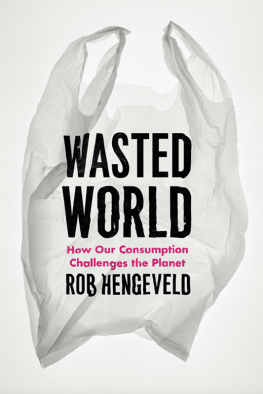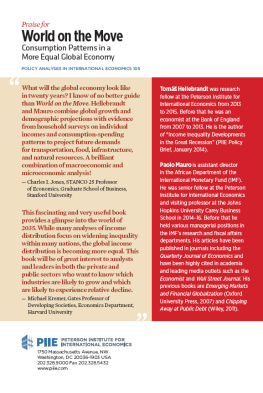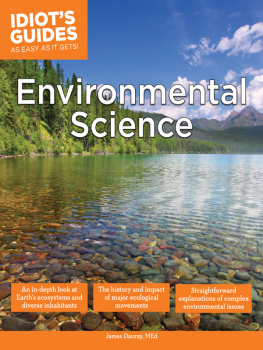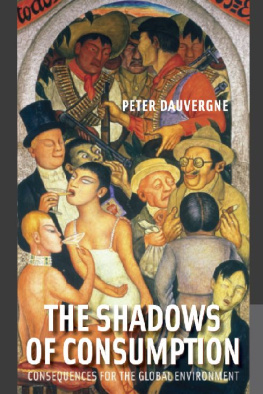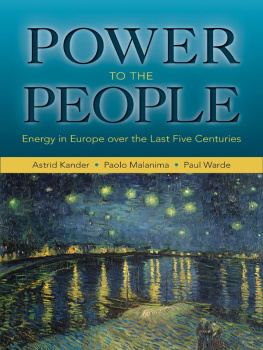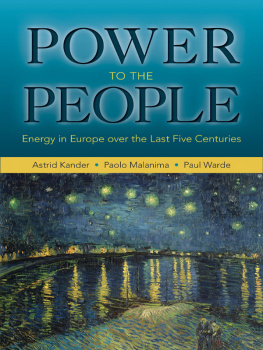Contents
Guide
LIMITS OF CONSUMPTION
Environmental Degradation
and
Ancient Wisdom
Gauri Shankar Gupta

First published in Great Britain by Hansib Publications in 2018
Hansib Publications Limited
P.O. Box 226, Hertford
Hertfordshire SG14 3WY UK
www.hansibpublications.com
Copyright Gauri Shankar Gupta
ISBN: 978-1-910553-94-7 (PDF)
ISBN 978-1-910553-96-1 (ePub)
ISBN 978-1-910553-97-8 (Kindle)
A CIP catalogue record for this book
is available from the British Library
All rights reserved. Without limiting the rights under copyright reserved above no part of this publication may be reproduced, stored in or introduced into a retrieval system, or transmitted, in any form or by any means (electronic, mechanical, photocopying recording or otherwise), without the prior written permission of both the copyright owner and the publisher of this book.
Production by Hansib Publications Limited
Printed in Great Britain

CONTENTS
TABLES AND CHARTS
PREFACE
Existence of life is closely inter-twined with nature. Nature provides the support system for survival of different species of life. As evident from historical records, for thousands of years humanity lived in harmonious relationship with nature. The Industrial Revolution marked a major turning point in Earths ecology and humans relationship with their environment. However, the full impact on the worlds psyche would not begin to register until the early 1960s, some 200 years after its beginnings when machines began to replace human beings in workplaces and mass production from large-scale industries at lower prices started flooding the market. Overtime Industrial Revolution profoundly impacted every aspect of human life from food to clothing, from sports to music, from education to medicine, from habitation to work places, from transportation to communication, from entertainment to travel, from relationships to sex and from production to distribution to consumption completely transforming the life-style. New sources of energy, communication and transport services provided unprecedented mobility never seen before.
Simultaneously, new technologies, increased automation, mass production & marketing and globalization transformed the economic land-scape world-wide. Gradual disappearance of small and cottage industries and large-scale mechanization of agriculture, considerably reduced employment opportunities in rural areas. All these factors led to massive migration to cities. With unprecedented increase in production and services, Global Gross Domestic Product has recorded massive growth since 1950 giving birth to what we call consumer society. It now takes less than two weeks for the world to produce the same output as the whole of the year 1900. However, despite massive economic growth; large-scale incidence of hunger and poverty, extreme inequality of income and wealth, and large and growing urban slums continue to characterize human society.
Moreover, this massive economic growth has come at a great cost. Finite resources of the planet are taking a serious toll. Extraction of minerals is taking place at an unprecedented rate. With increasing use of chemicals and pesticides, intensive agriculture and continuing deforestation over 35 percent of worlds top soil has been degraded. Fresh water consumption has gone up 9 times during the last century due to increasing industrial, agricultural and municipal use. Per capita availability of fresh water on a global basis is falling rapidly. Water bodies are getting contaminated with increasing amount of industrial and municipal effluent. Rivers and lakes are shrinking and marine life has been seriously affected. In addition, about 1.7 billion tons of solid municipal waste is generated every year poisoning the land and oceans. Due to growing air contamination, quality of air has deteriorated in all the major cities around the world directly threatening human health. Anthropogenic greenhouse gas emissions have increased substantially giving rise to global warming. Glaciers and ice sheets are melting, sea levels are rising and biodiversity is fast declining. Weather patterns are becoming increasingly erratic with increasing number of floods, droughts, hurricanes and unseasonal heat and cold waves.
Since 1972 a large number of international conferences have been held on these issues churning out a plethora of declarations and documentation with very little change on the ground. The question therefore is whether the humanity can sustain the ever-growing consumption, increasing inequality and unprecedented contamination and if so for how long. This book is based on my research undertaken in collaboration with the Budapest University of Technology and Economics, on these core issues affecting the very existence of human life and the sustainability of the economic path we are pursuing as a human race. I am therefore especially grateful to the Budapest University of Technology and Economics and in particular to Prof. Annamaria Orban for offering me this opportunity and to the Central European University for allowing me access to their rich library and research papers.
I am particularly grateful to my son Kartikaya Gupta for his support in preparing many of the charts and images included in the book and for arranging permission for use of certain images and graphs borrowed from other research publication and institutions. I am also grateful to Kinga Szabo for providing me support for my stay and work in Budapest. But for their support, I could not have accomplished this task.
I must record my very special thanks to Mr. Arif Ali of Hansib Publications Limited, Hertford, United Kingdom for agreeing to publish this work. But for his support it would not have possible to bring this work in public domain. His team of professionals carried out a magnificent job in designing, printing and marketing of the book.
Gauri Shankar Gupta
CHAPTER 1
SUSTAINABLE DEVELOPMENT AN INTRODUCTION
I. Overview
Existence of life is closely inter-twined with nature. Nature provides the support system for survival of different species of life that exist on the planet Earth. Similarly, our survival as human race is completely dependent on nature. The air we breathe, the water we drink, the food we eat, the clothing we wear, the habitation we live in, the energy we use and all other things we consume come directly from the nature surrounding us. Precisely because of this, many ancient civilizations have termed nature as our mother. As evident from historical records quoted in the next section; for thousands of years humanity lived in harmonious relationship with nature.
The industrial revolution marked a major turning point in earths ecology and humans relationship with their environment and dramatically changed every aspect of human life and lifestyle. However, the impact on the worlds psyche would not begin to register until the early 1960s, some 200 years after its beginnings. From human development, health and life longevity, to societal changes, public health, energy usage, consumption patterns and sanitation; the effects are profound. It wasnt that the industrial revolution became a stalwart juggernaut overnight. It started in the mid-1700s in Great Britain when machinery began to replace manual labour. Fossil fuels replaced wind, water and wood; used primarily for the manufacture of textiles and the development of iron making processes. The full impact of the industrial revolution started to register when the use of machines to replace human labour spread throughout Europe and North America. These processes gave rise to sweeping increases in production capacity and would affect all basic human needs, including food production, medicine, housing, and clothing. Mass production replaced small and cottage industries over time. The birth of the industrial revolution altered medicine and living standards, resulting in the population explosion that would commence at that point and steamroll into the 20th and 21st centuries. In only 100 years after the onset of the industrial revolution, the world population would grow 100 percent to two billion people in 1927 (McLamb, 2011). Continuing scientific innovations have further accelerated the processes set in motion by the industrial revolution far beyond one could imagine in the 18th century.

